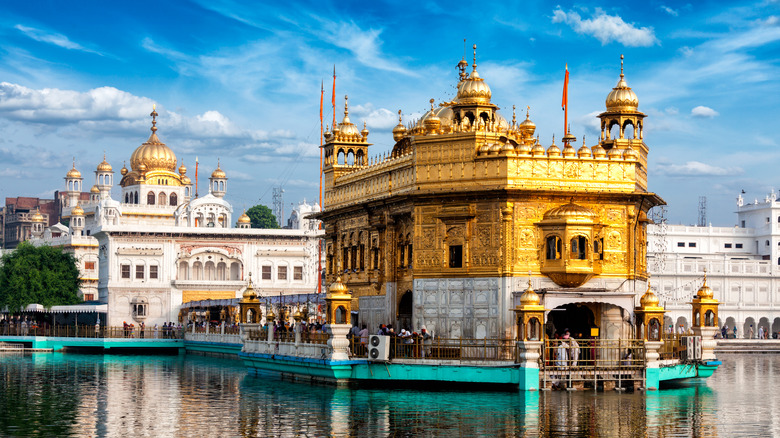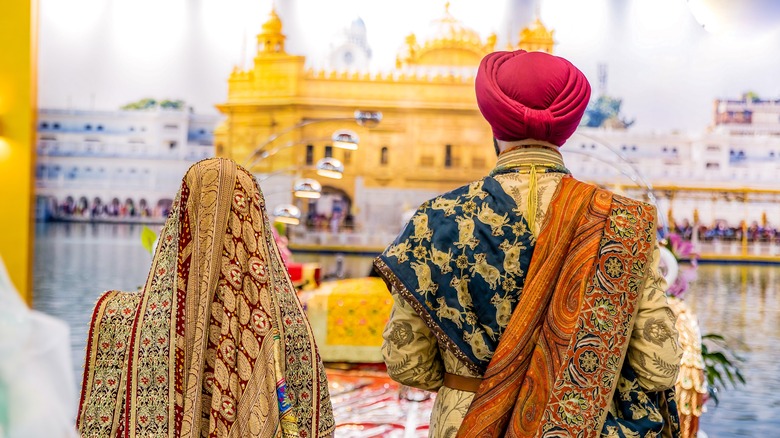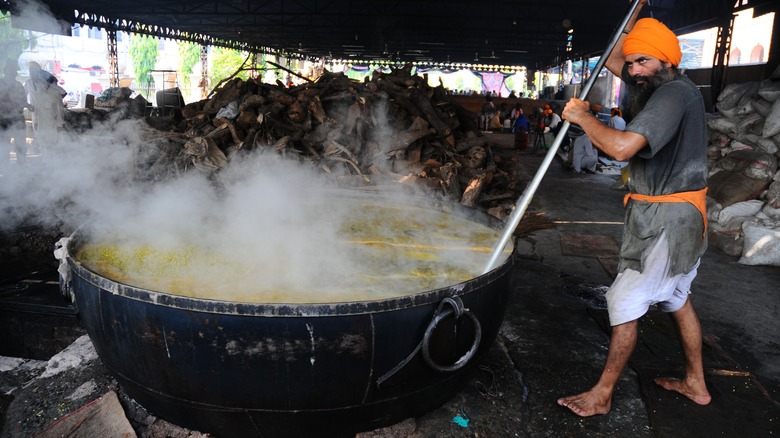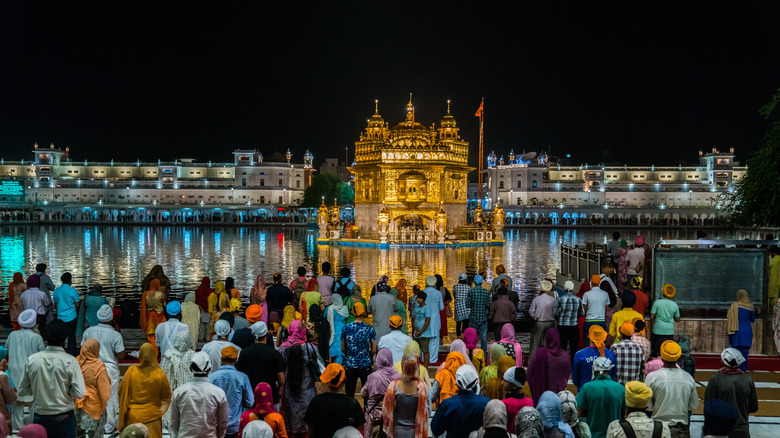How India's Golden Temple Feeds 100,000 People A Day
Anyone who's volunteered at a soup kitchen can tell you precisely how much humans eat (a lot), and how much work it takes to set up (a lot). We've got giant pots of soup or stew, maybe pieces of bread and spoonfuls of vegetables, some goodies here and there, plates and utensils, tables and chairs, napkins and garbage cans, bathroom facilities, set up and clean up, etc. It's a lot of work even for a small number of visitors, in the same way that quaint kids' parties and weekend potlucks always wind up being more work than expected. This is why food banks, charities, churches, and more require an incessant influx of foodstuffs to care for those in need, and an army of volunteers to run operations. So how in the world could one single building possibly prepare enough food to feed 100,000 people per day?
To a Sikh, a member of the world's fifth most widely practiced religion, the answer is simple: "seva," or selfless service, love, and kindness, as the BBC describes. It really is that simple — no excuses, complaints, divisions, haughtiness, entitlement, or foolishness involved. Sikhism's holiest site, the Golden Temple in the city of Amritsar in Punjab, India, receives a deluge of visitors every single day and has an equally enormous retinue of caretakers and food preparers who practice what they preach. Anyone can go, any time, any day, 24 hours, from any background, creed, class, or anything else, and not go hungry.
Universal oneness
In a world that seems hellbent on riling up as much antagonism, bitterness, strife, and resentment as possible, Amritsar's Golden Temple and Sikhism at large could seem like a delirious hallucination. But to understand why so many Sikhs devote so much time and effort to caring for others we've got to go back to the roots of Sikhism about 500 years.
As a religion, Sikhism took hold in the same region where it's still most widely practiced: The state of Punjab in India's north along the border with Pakistan, per The Conversation. Of course, when Sikhism's founder Guru Nanak was born in 1469 C.E. there were no such borderlines. In selfsame fashion, Guru Nanak envisioned a world without class and tribal divisions, and without religious and moral hypocrisy. The British Library says he was born in the Khatri caste — a traditional caste of accountants — to Hindu parents. He worked as a storekeeper for a local Muslim official, and around 30 years old had a revelation about the unity, or oneness, of all people.
As such, Sikhism's Venn Diagram-like tenets perfectly reflect its location on the globe. From Hinduism it borrows lineages of gurus (seen on Dhansikhi), from Islam monotheism, and from Buddhism teachings about severing attachments to Maya, aka the world of illusion, aka the material world of ego, greed, anger, and so forth, as Discover Guru Nanak explains. In the end, Sikhism professes and practices a distilled creed of sharing, caring, honesty, truth, humility, and common decency.
Selfless service
Like other religions, Sikhism has rituals, holy texts, and theological terminology. The British Library, for instance, says that the word "Sikh" means "learner," as opposed to "Guru," which means "teacher." The Sikh Coalition says that the lineage of Sikh gurus wrote the Guru Granth Sahib, a collection of revered texts that guide practitioners today. The Conversation talks about Sikhism's five k's: "kes (long, uncut hair), kara (steel bracelet), kanga (wooden comb), kirpan (small sword) and kachera (soldier-shorts)." Then there's the ever-recognizable turban, a Sikh head wrapping that conveys respect in the presence of the divine.
And yet, the facet of Sikhism that makes it stand out — and allows places like the Golden Temple in Amritsar to feed 100,000 people per day — is Sikhism's practical-mindedness. Sikhs the world over don't natter about petty points of doctrine, engage in phone-screen activism, or derail useful work. They take action. "Seva" is the term for Sikhism's principles in action, and The Sikh Coalition shows plenty of sevadaars — those who practice seva — at work. When COVID-19 hit, Sikhs delivered food to the needy, per the BBC and CNN. When floods hit British Columbia in 2021, Sikhs were there for those who suffered, per CTV News. When Cyclone Gabrielle hit Hawke's Bay in New Zealand, Sikhs did the same, per the New Zealand Herald. So the Golden Temple in Amritsar? It's just another example of selfless service in action.
A holy pilgrimage site
Some may be wondering how the Golden Temple manages endless meals of lentils, chapatis (flatbread), chickpea stew, and yogurt. But despite potential chaos, the whole thing works because everyone's in it together and abides by the same principles. The BBC describes large, multiple, 200-person halls throughout the Golden Temple tended to "with utmost discipline" by volunteers. There's an "implicit choreography" behind it all. Everyone knows what to do, how to do it, doesn't dawdle, eats their fill, and leaves. Every 15 minutes — much more dutifully than some servers at exorbitant Western restaurants, let's say — volunteers sweep through, collect used stainless steel plates, clean up, and resume the cycle. Sikhs are familiar with these places, called langars, which allow anyone, anytime, anywhere, to enter and receive help.
On top of all this, the Golden Temple is a particularly special place for Sikhs. Sikhs in general perform service in temples — called gurudwaras — like cleaning, caretaking, serving meals, and so forth. The Golden Temple, though, is the "central religious place of the Sikhs," as the temple's website says. People travel there every day to pay respects. But at the same time the Golden Temple isn't remote and inaccessible — it's a place of community embedded in a multifaith city. Children play there, people of various backgrounds mingle there, and everyone earnestly does their best to contribute. Maybe in the end this is what makes the Golden Temple, and Sikhism as a whole, so special.



